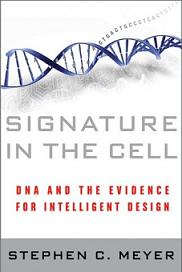
Stephen C. Meyer has published a (very long, but readable) book, Signature in the Cell: DNA and the Evidence for Intelligent Design,
outlining his argument in favor of intelligent design. This book
essentially argues that life is very complex, the origin of life is a
puzzle, and the information content in DNA cannot be explained by
natural means.
The central chapters in Meyer’s book discuss the issues in origin of life research. He takes a somewhat meandering path – but this is the goal. The origin of life is a complex problem – and that is putting it mildly. Textbooks and such, especially at the K-12 and even undergraduate level often leave the impression that it is a solved problem – all that remains is to fill in minor details, dot the i’s and cross the t’s so to speak.
One website www.kidsbiology.com puts it like this:
Earth’s ancient oceans, while lifeless, but were filled with the chemicals needed for life. These chemicals were not alive, but they were there, sloshing around. They call these chemicals “Primordial soup”. Instead of alphabets, this soup was filled with amino acids, proteins, lipids, and other basic components that are commonly found in life forms today.
It is believed that life began on the shores of these ancient oceans, in pools of water called tidal pools. These shallow pools would have been full of this “life soup”. Over many millions of years, as the ingredients of life splashed around in these pools, possibly helped by lightning strikes, they formed the first cells.
Another site – geared toward helping students prepare for the SAT (sparknotes.com) says:
Life on Earth began about 3.5 billion years ago. At that point in the development of the Earth, the atmosphere was very different from what it is today. As opposed to the current atmosphere, which is mostly nitrogen and oxygen, the early Earth atmosphere contained mostly hydrogen, water, ammonia, and methane.
In experiments, scientists have showed that the electrical discharges of lightning, radioactivity, and ultraviolet light caused the elements in the early Earth atmosphere to form the basic molecules of biological chemistry, such as nucleotides, simple proteins, and ATP. It seems likely, then, that the Earth was covered in a hot, thin soup of water and organic materials. Over time, the molecules became more complex and began to collaborate to run metabolic processes. Eventually, the first cells came into being. These cells were heterotrophs, which could not produce their own food and instead fed on the organic material from the primordial soup. (These heterotrophs give this theory its name.)
Not only are these broad brush descriptions simplified – they are,
quite simply, wrong. The atmosphere likely contained little ammonia or
methane, rather a good bit of CO2 – more like Mars or Venus
today. Electrical discharge, radioactivity and ultraviolet light make a
mixture better classed as goo – and goo that is not exactly conducive
to life. Even if there were shallow pools of amino acids, proteins, lipids – and organic soup – formation of life by chance as the textbooks suggest is not a plausible hypothesis.
If there is a wide open field to look for evidence of intelligent design – this is it.
What have you been taught about the origin of life?
In chapters 8-14 (pp. 173-295) Meyer looks first at probability and pattern recognition, and then turns to the study of the origin of life. This has been an active area of both research and speculation for decades, many have tackled the problem and many more have dabbled. Meyer gives something of a historical description of many of the proposals and why they fail. For the most part his discussion is uncontroversial, all of these proposals and ideas have serious flaws, only a few devotee’s would claim otherwise. Meyer does a pretty good job of describing the constraints under which origin of life theories must operate. At the base there must be a self-replicating molecular system capable of carrying information from one generation to the next.
The core of Meyer’s case for intelligent design is the conservation law he proposes at the end of chapter 14.
In a nonbiological context and absent intelligent input, the amount of specified information of a final system, Sf, will not exceed the specified information content of the initial system, Si, by more than the number of bits of information the system’s probabilistic resources can generate (p. 294)
Probabilistic resource, a key concept in Meyer’s book, requires a bit of definition (see Ch. 8 and 10). This is a bit of an over simplification but … assume you flip five coins and want all heads. There are 25 = 32 possible outcomes of a single toss. To have a reasonable probability of all heads you must have time toss a substantial fraction of 32 times. Probabilistic resources means there must be an opportunity for there to be a reasonable probability for an event to have occurred. As biological problems are complex – probabilistic resource can become an important constraint on plausibility.
Consider a relatively simple biological problem with which I have some familiarity – the protein folding problem. Proteins are large complex peptide chains composed of an aperiodic string of amino acids. The upper two images to the right show an atomistic view and a ribbon view of myoglobin, a small protein with 153 amino acids. For a protein to perform a useful function it must fold into a highly specific three-dimensional shape as shown for myoglobin. Yet even a small protein of ca. 100 amino acids will have some 1095 possible configurations of which very few are functional. This leads us to ask how a protein finds the right configuration. Is folding the result of a random sampling of available configurations? An upper limit for sampling each conformation would be one every picosecond (10-12 sec). As there have been less than 1030 picoseconds since the big bang (14 billion years ago) it is clear that the “probabilistic resource” is not sufficient for protein folding to be a chance occurrence – a random sampling of available configuration space. This statement of the protein folding problem is known as The Levinthal Paradox. Proteins fold in a small fraction of a second in some kind of a directed process governed by both chance and necessity, elucidation of the mechanism is an active research problem. Some large proteins use other proteins called chaperones to assist in folding. Protein misfolding can be a problem – as in diseases such as mad cow and Creutzfeldt-Jakob disease.
The origin of life is also not a chance driven process. The complexity of a simple cell leads to problems with “probabilistic resource” much larger than that calculated for the protein folding problem. This in turn leads to a conclusion that the origin of life is also governed by both chance and necessity. In some fashion the origin of life is encoded into the natural laws of the universe. This is not a controversial statement. I think that it is agreed to by most origin of life researchers and provides something of a constraint for the consideration of potential mechanisms for the origin of life. Given a hospitable environment life will develop with reasonable probability. Mechanisms that are proposed should generally acknowledge this.
Simon Conway Morris (Life’s Solution), Owen Gingerich (God’s Universe), and Alister McGrath (A Fine-Tuned Universe) all suggest that we may, in fact, see evidence for God in the design of a universe conducive to inevitable life. Francis Collins has made similar suggestions in lectures that he has given.
Meyer takes this one step further – he proposes that the origin of life problem cannot be solved by chance and necessity (i.e. the kind of combination of random sampling and natural law proposed for protein folding), but in fact requires design at the level of the information content of the first cell. His hypothesis is that the “probabilistic resource” of the universe is insufficient for life to have developed from self-organization operating under the laws of chemistry and physics.
Enough for one post.
Response, ideas, questions? Do you think that the origin of life is evidence for a designer and where would you see this evidence for design?

